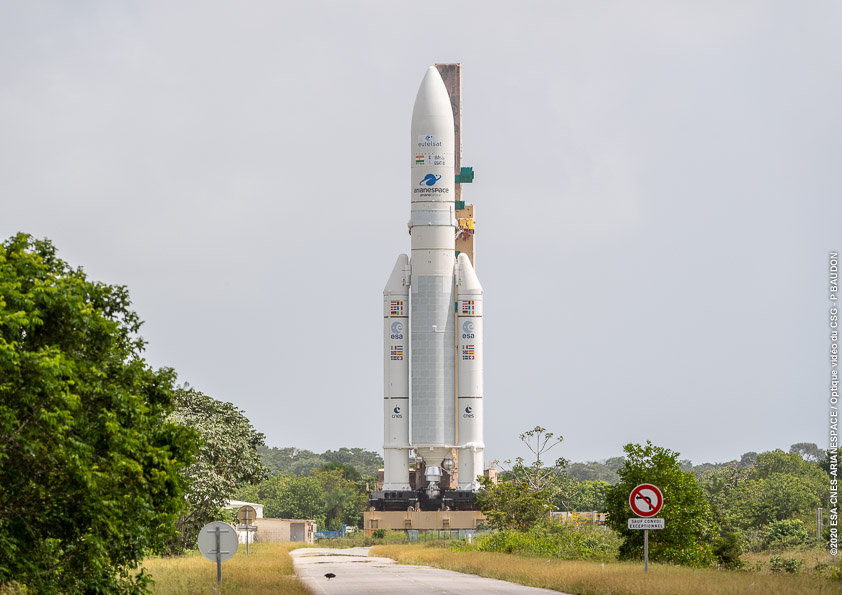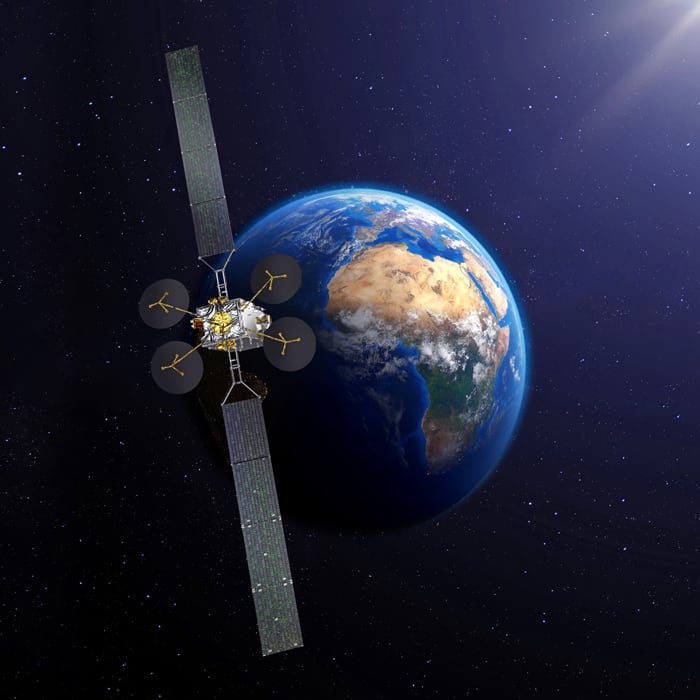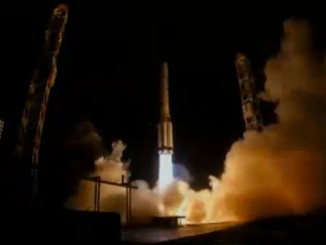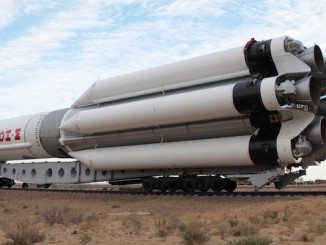
A broadband communications satellite for Paris-based Eutelsat — built on a new Thales Alenia Space all-electric design with xenon plasma thrusters — and an Indian broadcasting spacecraft are fastened to the top of an Ariane 5 launcher for liftoff Thursday from French Guiana.
Liftoff is scheduled during a launch window opening at 4:05 p.m. EST (2105 GMT) and closing at 6 p.m. EST (2300 GMT) Thursday.
The mission will mark the 107th flight of an Ariane 5 rocket since 1996, and the 251st flight of a launcher in the European Ariane family since 1979. It will be the first of up to 22 launches this year for Arianespace, the French launch services provider, using Ariane 5, Soyuz and Vega boosters from launch sites in French Guiana, Kazakhstan and Russia.
After lifting off from the tropical space base on the northeastern coast of South America Thursday, the Ariane 5 will deliver the Eutelsat Konnect and GSAT 30 satellites to an elliptical geostationary transfer orbit ranging between 155 miles (250 kilometers) and 22,220 miles (35,761 kilometers), with an orbit tilted 6 degrees to the equator.
Separation of the two satellites from the Ariane 5 launcher’s upper stage is planned around a half-hour after liftoff.
Each satellite will use its own propulsion to circularize its orbit at geostationary altitude more than 22,000 miles over the equator, where their velocities will match the rate of Earth’s rotation, giving each spacecraft a fixed geographic coverage zone.
The Eutelsat Konnect satellite is the largest of the two payloads on Thursday’s mission.
Built by Thales Alenia Space, the Eutelsat Konnect spacecraft will provide broadband connectivity over Europe and Africa during a mission slated to last at least 15 years.

Eutelsat Konnect is the first spacecraft built on the new Spacebus Neo satellite bus, which was developed by Thales with funding from the European Space Agency and the French government, including the French space agency, CNES.
“Creating Spacebus Neo, a completely new product line, and in parallel meeting the schedule of the first satellite Konnect has been quite a challenge, which Thales Alenia Space and its consortium have brilliantly mastered,” said Magali Vaissiere, director of ESA’s telecommunications programs.
“This has only been possible through the successful cooperation between Thales Alenia Space and the agencies ESA and CNES, who have co-managed this project, the excellent coordination with Eutelsat, and the continued support of our European member states.
ESA helped fund development through the space agency’s Neosat program, which aims to develop new European satellite designs with reduced cost and increased capabilities, ensuring Europe’s large satellite manufacturing base remains competitive in the global market.
ESA’s Neosat program supported the development of new satellite platforms by Thales and Airbus Defense and Space. Eutelsat, the largest commercial European satellite operator, agreed to be the first customer for both of the new satellite designs.
The Thales Spacebus Neo satellite platform will debut with Thursday’s launch, and the Airbus Eurostar Neo platform will launch for the first time in 2021.
The Spacebus Neo platform features an all-electric propulsion system with xenon-fueled ion thrusters to perform all the satellite’s post-launch maneuvers.
The low-thrust, high-efficiency xenon jets mean it will take several months for the Eutelsat Konnect satellite to reach its final operating station in geostationary orbit, but the all-electric propulsion system comes with major benefits.
“Eutelsat Konnect is the first satellite to use the Spacebus Neo electric propulsion platform from Thales Alenia Space,” said Peter Newell, Eutelsat Konnect’s program manager at Eutelsat. “Satellites using electric propulsion provide effective solutions for satellite operators, allowing them to maximize the payload capability of the satellite while maintaining a low overall spacecraft mass.
“As the first of its kind, there have many challenges during the development, qualification, manufacturing and test phases, but thanks to the skill and expertise of the Thales, Eutelsat and ESA/CNES teams, the satellite has been brought conception to today’s launch in just four years, which is a great achievement.”
The Eutelsat Konnect spacecraft, which rides in the upper position of the Ariane 5 launcher’s payload bay, weighs 7,978 pounds (3,619 kilograms) at liftoff, significantly less than a similarly-capable communications satellite that used conventional chemical hydrazine fuel.

The Spacebus Neo satellite platform joins other all-electric geostationary satellite buses currently flying from other satellite manufactures, including Boeing, Maxar and Northrop Grumman.
The xenon propulsion package was developed by Thales teams in the United Kingdom, and the payload module comes from a facility in Toulouse, France. Final assembly of the Eutelsat Konnect satellite occurred at a Thales site in Cannes, France.
Eutelsat Konnect is expected to enter commercial service this fall after the slow, multi-month orbit-raising campaign.
The high-power satellite hosts a Ka-band communications payload with a total capacity of 75 gigabits per second, providing Internet services for individuals and companies in Europe and Africa. Eutelsat Konnect will also link with public WiFi hotspots in Africa to provide Internet service to mobile phones and other devices.
“Thanks to its 92 user beams with four deployable antennas, the satellite provides coverage to 15 countries in Europe and 45 countries in Africa,” Newell said. “In bringing broadband Internet to Africa and Europe with state-of the-art satellite telecommunication technology, Eutelsat Konnect will make a major contribution in bridging the digital divide.
“Initially, Eutelsat Konnect will operate in both Europe and Africa combined, but thanks to the high flexibility… it will be possible in the future to reallocate all of the satellite capacity to the African market,” Newell said.
After releasing the Eutelsat Konnect spacecraft, the Ariane 5’s upper stage will re-orient itself for separation of GSAT 30, the smaller of the two payloads on Thursday’s launch.
The 7,400-pound (3,357-kilogram) GSAT 30 spacecraft, built and operated by the Indian Space Research Organization, will replace the aging Insat 4A spacecraft, which launched in 2005 on a previous Ariane 5 mission.
GSAT 30 will operate from a position in geostationary orbit at 83 degrees east longitude over the equator.

“GSAT 30 will provide continuity of direct-to-home TV services from this slot, as well as digital satellite news-gathering and very small aperture terminal services,” said K. Sivan, ISRO’s chairmen. “The Ku-band transponders will provide services over the Indian mainland and islands.
“The satellite employs high-power amplifier and state-of-the-art antenna systems to meet the requirements of multiple users,” Sivan said.
“The GSAT 30 communications payload is equipped with 12 C-band transponder and 12 Ku-band trapsonders,” said D.K. Das, director of ISRO’s Satellite Applications Center. “The C-band transponders are designed for two-way communications using VSAT terminals over a vast geographic region extending up to Australia in the east and Europe in the west.”
Email the author.
Follow Stephen Clark on Twitter: @StephenClark1.



